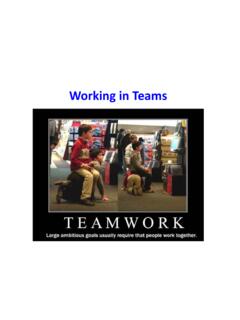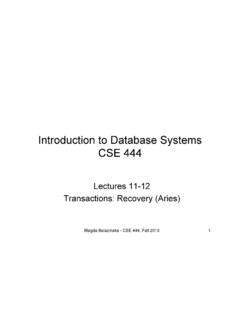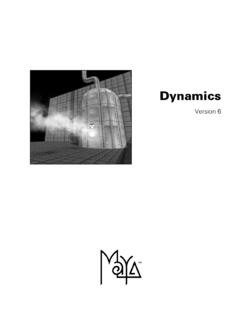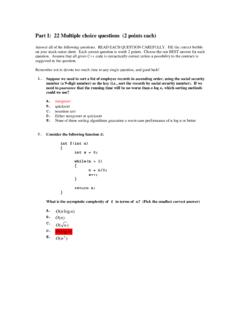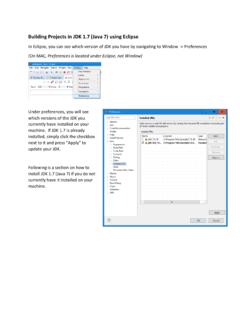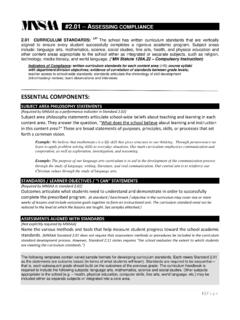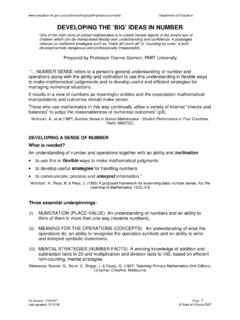Transcription of Software Project Estimation - University of Washington
1 Software Project EstimationEffective Software Project Estimation is one of the most challenging and important activities in softwaredevelopment. Proper Project planning and control is not possible without a sound and reliable estimate. As awhole, the Software industry doesn t estimate projects well and doesn t use estimates appropriately. Wesuffer far more than we should as a result and we need to focus some effort on improving the a Project leads to under-staffing it (resulting in staff burnout), under-scoping the qualityassurance effort (running the risk of low quality deliverables), and setting too short a schedule (resulting inloss of credibility as deadlines are missed). For those who figure on avoiding this situation by generouslypadding the estimate, over-estimating a Project can be just about as bad for the organization! If you give aproject more resources than it really needs without sufficient scope controls it will use them.
2 The Project isthen likely to cost more than it should (a negative impact on the bottom line), take longer to deliver thannecessary (resulting in lost opportunities), and delay the use of your resources on the next Project Estimation 101 The four basic steps in Software Project Estimation are:1) Estimate the size of the development product. This generally ends up in either Lines of Code(LOC) or Function Points (FP), but there are other possible units of measure. A discussion of thepros & cons of each is discussed in some of the material referenced at the end of this ) Estimate the effort in person-months or ) Estimate the schedule in calendar ) Estimate the Project cost in dollars (or local currency)Estimating sizeAn accurate estimate of the size of the Software to be built is the first step to an effective estimate. Yoursource(s) of information regarding the scope of the Project should, wherever possible, start with formaldescriptions of the requirements - for example, a customer s requirements specification or request forproposal, a system specification, a Software requirements specification.
3 If you are [re-]estimating a Project inlater phases of the Project s lifecycle, design documents can be used to provide additional detail. Don t letthe lack of a formal scope specification stop you from doing an initial Project estimate. A verbal descriptionor a whiteboard outline are sometimes all you have to start with. In any case, you must communicate thelevel of risk and uncertainty in an estimate to all concerned and you must re-estimate the Project as soon asmore scope information is main ways you can estimate product size are:1) By analogy. Having done a similar Project in the past and knowing its size, you estimate eachmajor piece of the new Project as a percentage of the size of a similar piece of the previous the total size of the new Project by adding up the estimated sizes of each of the pieces. Anexperienced estimator can produce reasonably good size estimates by analogy if accurate sizevalues are available for the previous Project and if the new Project is sufficiently similar to theprevious ) By counting product features and using an algorithmic approach such as Function Points to convertthe count into an estimate of size.
4 Macro-level product features may include the number ofsubsystems, classes/modules, methods/functions. More detailed product features may include thenumber of screens, dialogs, files, database tables, reports, messages, and so effortOnce you have an estimate of the size of your product, you can derive the effort estimate. This conversionfrom Software size to total Project effort can only be done if you have a defined Software developmentlifecycle and development process that you follow to specify, design, develop, and test the Software . Asoftware development Project involves far more than simply coding the Software in fact, coding is oftenthe smallest part of the overall effort. Writing and reviewing documentation, implementing prototypes,designing the deliverables, and reviewing and testing the code take up the larger portion of overall projecteffort. The Project effort estimate requires you to identify and estimate, and then sum up all the activitiesyou must perform to build a product of the estimated are two main ways to derive effort from size:1) The best way is to use your organization s own historical data to determine how much effortprevious projects of the estimated size have taken.
5 This, of course, assumes (a) your organizationhas been documenting actual results from previous projects, (b) that you have at least one pastproject of similar size (it is even better if you have several projects of similar size as this reinforcesthat you consistently need a certain level of effort to develop projects of a given size), and (c) thatyou will follow a similar development lifecycle, use a similar development methodology, usesimilar tools, and use a team with similar skills and experience for the new ) If you don t have historical data from your own organization because you haven t started collectingit yet or because your new Project is very different in one or more key aspects, you can use amature and generally accepted algorithmic approach such as Barry Boehm s COCOMO model orthe Putnam Methodology to convert a size estimate into an effort estimate. These models have beenderived by studying a significant number of completed projects from various organizations to seehow their Project sizes mapped into total Project effort.
6 These industry data models may not be asaccurate as your own historical data, but they can give you useful ballpark effort scheduleThe third step in estimating a Software development Project is to determine the Project schedule from theeffort estimate. This generally involves estimating the number of people who will work on the Project , whatthey will work on (the Work Breakdown Structure), when they will start working on the Project and whenthey will finish (this is the staffing profile ). Once you have this information, you need to lay it out into acalendar schedule. Again, historical data from your organization s past projects or industry data models canbe used to predict the number of people you will need for a Project of a given size and how work can bebroken down into a you have nothing else, a schedule Estimation rule of thumb [McConnell 1996] can be used to get a roughidea of the total calendar time required:Schedule in months = * (effort-months) 1/3 Opinions vary as to whether or or even should be used in place of the value only by trying itout will you see what works for CostThere are many factors to consider when estimating the total cost of a Project .
7 These include labor, hardwareand Software purchases or rentals, travel for meeting or testing purposes, telecommunications ( , long-distance phone calls, video-conferences, dedicated lines for testing, etc.), training courses, office space, andso how you estimate total Project cost will depend on how your organization allocates costs. Somecosts may not be allocated to individual projects and may be taken care of by adding an overhead value tolabor rates ($ per hour). Often, a Software development Project manager will only estimate the labor cost andidentify any additional Project costs not considered overhead by the simplest labor cost can be obtained by multiplying the Project s effort estimate (in hours) by a generallabor rate ($ per hour). A more accurate labor cost would result from using a specific labor rate for each staffposition ( , Technical, QA, Project Management, Documentation, Support, etc.)
8 You would have todetermine what percentage of total Project effort should be allocated to each position. Again, historical dataor industry data models can dataAnalyze theestimationprocessActual size,effort, costdataApprovedEstimate(s)Collect the initialrequirementsEstimate productsizeEstimate the effortProduce thescheduleEstimate the costApprove theestimateDevelop theproductRe-estimateas neededFigure 1 The Basic Project Estimation ProcessWorking Backwards from Available TimeProjects often have a delivery date specified for them that isn t negotiable - The new release has to be outin 6 months ; The customer s new telephone switches go on-line in 12 months and our Software has to beready then . If you already know how much time you have, the only thing you can do is negotiate the set offunctionality you can implement in the time available. Since there is always more to do than time available,functionality has to be prioritized and selected so that a cohesive package of Software can be delivered backwards doesn t mean you skip any steps in the basic Estimation process outlined above.
9 Youstill need to size the product, although here you really do have to break it down into a number of pieces youcan either select or remove from the deliverable, and you still need to estimate effort, schedule, and is where Estimation tools can be really useful. Trying to fit a set of functionality into a fixed timeframerequires a number of what if scenarios to be generated. To do this manually would take too much timeand effort. Some tools allow you to play with various options easily and an Estimate s AccuracyWhenever an estimate is generated, everyone wants to know how close the numbers are to reality. Well, thebottom line is that you won t know exactly until you finish the Project and you will have to live withsome uncertainty. Naturally, you will want every estimate to be as accurate as possible given the data youhave at the time you generate it. And of course you don t want to present an estimate in a way that inspiresa false sense of confidence in the do we mean by an accurate estimate?
10 Accuracy is an indication of how close something is toreality. Precision is an indication of how finely something is measured. For example, a size estimate of 70to 80 KLOC might be both the most accurate and the most precise estimate you can make at the end of therequirements specification phase of a Project . If you simplify your size estimate to 75000 LOC it looksmore precise, but in reality it s less accurate. If you offer the size estimate as 75281 LOC, it is precise toone LOC but it can only be measured that accurately once the coding phase of the Project is completed andan actual LOC count is your accurate size estimate is a range, rather than a single value, then all values calculated from it ( ,effort, schedule, cost) should be represented as a range as well. If, over the lifetime of a Project , you makeseveral estimates as you specify the product in more detail, the range should narrow and your estimateshould approach what will eventually be the actual cost values for the product or system you are developing(Figure 2).
